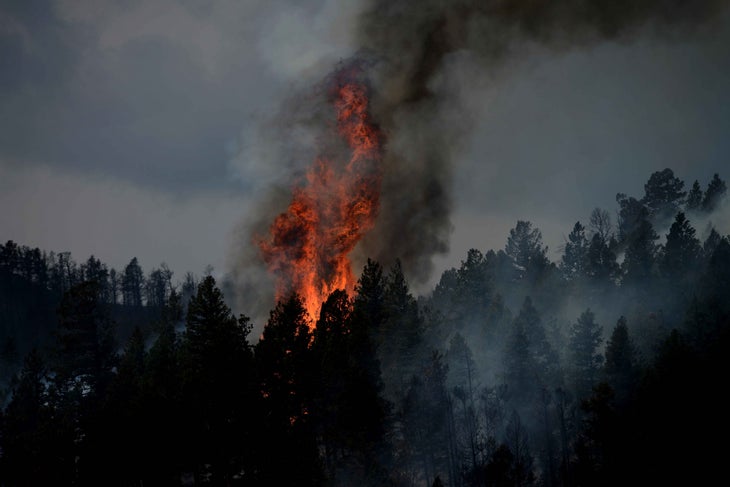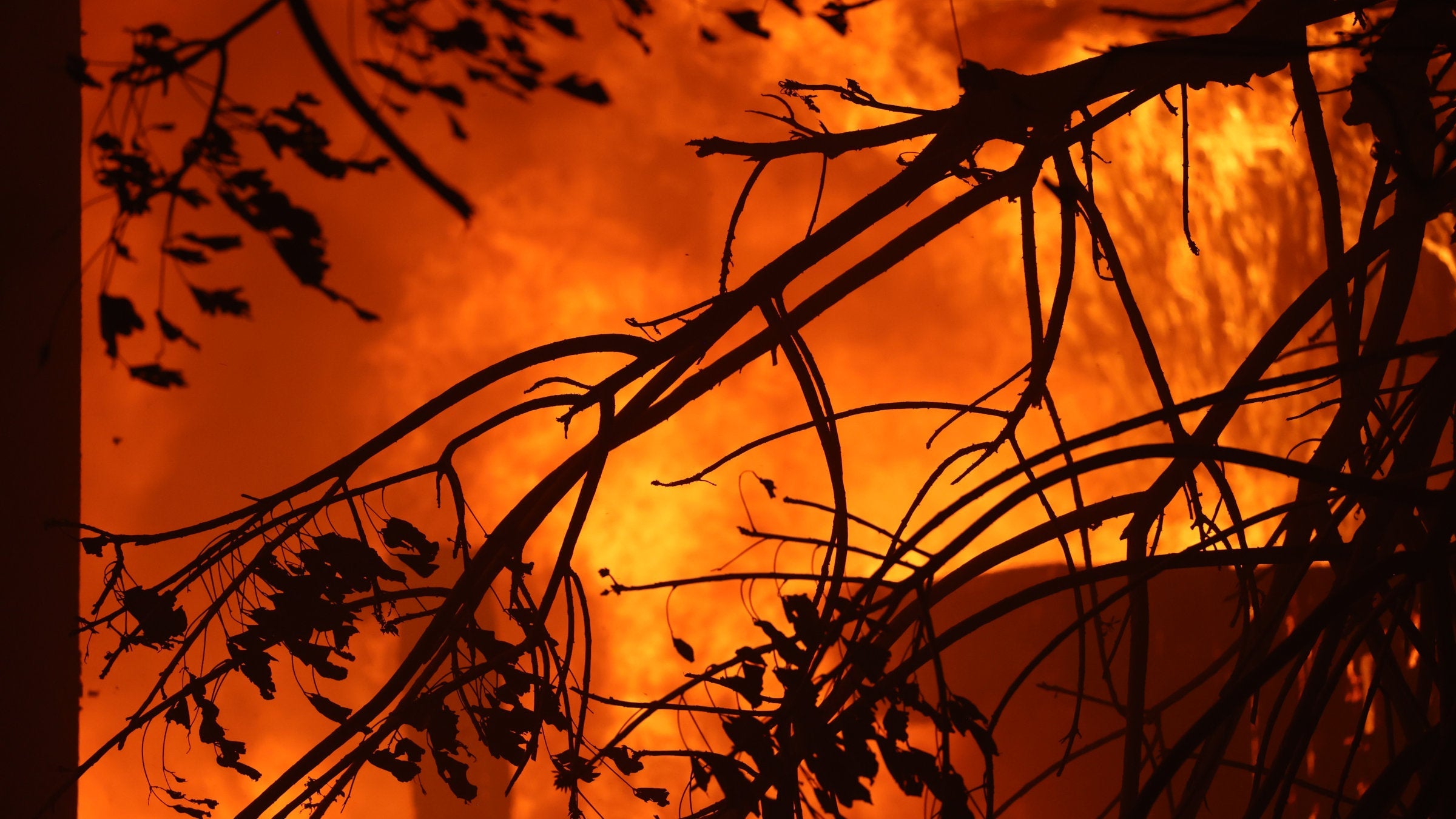Editor’s Note: We first published this story in January 2019 in the wake of the Camp Fire, the deadliest in California history. With the Palisades, Sunset, and Eaton Fires now raging across the Los Angeles area—and discussion about the role that U.S. forest policy might have played in creating the conditions for them following in their wake—we feel it’s as relevant as ever.
Fire ecologist Chad Hanson is standing knee-deep in downed trees and charred stumps when he spots what he’s been searching for: a pine sapling. He’s spent this sunny September day touring the burn scar left from the 2011 Las Conchas Fire, when a conflagration roared through northern New Mexico, torching 43,000 acres in a single night.
After that apocalypse, who would expect a pine forest to come back? Hanson does, and all day, he’s braved the thorny limbs of locusts and meandered among aspens just tinged with yellow to find it.
Hanson, who holds a Ph.D. in ecology from the University of California and co-authored the book , has built his career around fighting the notion that intense wildfires are wholly devastating. He argues they play a vital ecological role that starts with beetles and woodpeckers and spreads throughout the food web, and that when forest managers try to substitute fires with logging, they do real and lasting harm to the environment.
In the wake of 2018’s devastating wildfires, the upper echelons of the Trump administration have called for increased timber harvesting as a remedy. In public statements, the president blamed California’s deadly fire season, in which nearly 100 people lost their lives, on rivers being “diverted” to the Pacific Ocean and poor forest management.
In rebuttal, the California Department of Forest and Fire Protection’s Scott McClean told the Los Angeles Times there’s no shortage of water, adding, “The problem is changing climate leading to more severe and destructive fires.”
Like the president, former Interior Secretary Ryan Zinke blamed environmental activists for wildfires’ increased intensity.
“Every year we watch our forests burn, and every year there is a call for action,” last August. “Yet, when action comes, and we try to thin forests of dead and dying timber, or we try to sustainably harvest timber from dense and fire-prone areas, we are attacked with frivolous litigation from radical environmentalists who would rather see forests and communities burn than see a logger in the woods.”
But Hanson and other fire ecologists caution that the administration has it backwards: More logging can actually make wildfires burn hotter and faster. Instead, they say, it’s well-placed, smart management that will reduce the impacts to communities from wildfires—and unchecked logging is neither.

To understand scientists’ objections, there are a few important facts you need to know about last fall’s blazes in California.
“Most of what burned wasn’t forest,” says Matthew Hurteau, a professor at the University of New Mexico who studies forests, fires and climate adaptation. Instead, the fires burned mostly grass and shrubby chaparral. That’s been the case in several of the state’s most damaging fires: the Woolsey and Camp in 2018, Thomas and Tubbs in 2017, and even back to the Cedar Fire in 2003.
Creating varying tree densities and providing anchor points for wildland firefighters could reduce wildfire risks, as could prescribed burns, Hurteau says. But, he adds, “logging operations can actually increase the rate of speed at which fire moves across an area, depending on how the logging operation is conducted.”
Opening the canopy dries out the forest floor and increases wind speeds, both of which accelerate fire. Logging can also leave behind more combustible species like cheatgrass, an opportunistic invasive that thrives in disturbed areas and is near-impossible to eradicate. There’s also the simple fact that much of the densest forest is on terrain so steep that loggers’ machines couldn’t even access it.
“The idea that we’re going to mechanically thin our way out of the high-severity fire risk that we face on the west slope of the High Sierra is uninformed,” Hurteau says. “I don’t know any federal land managers—like the actual people working on national forests—who argue that timber extraction is really the way to modify the way fire interacts with the forest.”
Developing and implementing wildfire mitigation strategies is a challenge in and of itself. Each treatment program is designed for a purpose and with certain conditions in mind, says Chad Hoffman, associate professor of fire science at . Forest managers have to think about everything from funding to topography to social tolerance in surrounding areas.
“All treatments have some conditions in which they’re just not going to work the way we think,” he says. “When I explain this to students, I say it’s like the seatbelts in my car are not the same ones we use in NASCAR.”
Thinning and burning projects have a top limit on their effectiveness. If the forest is particularly dry or the wind particularly high, a wildfire could still run right over that preventive work. And while logging sometimes gets conflated with fuels treatment projects, Hoffman adds, they have very different goals. If logging efforts are leaving piles of “slash”—downed trees, limbs and other brush—or cutting all the big, market-ready trees and sparing only the little ones that are less likely to survive a conflagration, they’re not actually reducing the severity of wildfire.
“Sometimes those objectives do align with mitigation, but sometimes they don’t,” he says. “This really comes down to being purposeful and understanding the local scenario, and being clear with what those objectives are and what we believe we’re accomplishing.”
There’s also a question of basic math: The Forest Service alone manages 193 million acres; In any given year, thinning and burning projects reach less than 2 percent of that. And that doesn’t include additional lands overseen by the National Park Service or Bureau of Land Management.
Some research has suggested that, given the scale of the area with the potential to burn in a wildfire and our inability to actively manage every square mile, there are ways of assessing highest priority areas.
“If we could treat 20 percent and it’s the right 20 percent, that’s almost as good as treating much more of the landscape,” Hoffman says.
Hanson suggests concentrating thinning projects and prescribed burns around communities.“Any effort to focus more attention, more resources, more activity, more funding on forests distant from homes is going to divert finite resources away from true home protection,” he says.
Protecting communities also means building homes and businesses with fire-resistance in mind, using materials like metal rooftops and cement composite siding. Often, homes are lost to embers ahead of “the flaming front” by up to 10 miles, Hurteau says. Once one house starts—with a spark that catches on dry leaves in a rain gutter or drifts into an attic through a vent—the fire spreads house to house.
There’s also a need for improved warning systems to give people earlier notice to evacuate and more assistance with getting out of their homes. By most accounts, many residents of Paradise, California, were signaled to leave only by neighbors honking car horns and yelling.
One of the most pernicious factors in last year’s wildfire season is the one that the federal government has tried the hardest to ignore. In the midst of climate change, some of the worst-hit parts of California had seen barely any rain for months prior to the biggest blazes.
“When fire weather is high and extreme, the weather is going to be, overwhelmingly, the factor that drives how fast the fire spreads, not the type of vegetation or how dense it is,” says Hanson. In fact, an analysis of 1,500 wildfires over three decades that he coauthored found the forests with the least environmental protections and the most logging burned most intensely, all other factors being equal.
As tough as it may be for hikers and homeowners to accept, some forests might simply have to burn. Doing so would naturally reset the density of foliage and improve ecosystems’ overall health
“I don’t think there’s any way that we cut our way out of wildfires,” Hurteau says. “These are flammable landscapes. A lot of the species evolved with fire as a disturbance process, and we’ve been intervening in that with fire suppression for a long time. It’s critical that we actually begin to restore fire to these ecosystems in an ecologically appropriate manner.”
The Forest Service seems to be taking this science into account. During a conference on wildfire in May, Victoria Christiansen, the Forest Service’s interim chief and a career forester and firefighter, pointed to fuel buildup, drought, and climate change as drivers behind worsening fires. But the most significant component, she said, is the 120 million people who currently live in the wildland-urban interface—the area most at risk of wildfire. Protecting those residences and businesses has driven up fire suppression costs to the point that they currently consume more than half the agency’s budget..
The US fire season is now year-round, and fires are burning at greater frequency, size and severity than they did half a century ago, Christiansen added. Twenty years ago, it was rare to see a wildfire grow to more than 100,000 acres. In 2017, more than 12 fires burned that much acreage.
The agency plans to respond by helping to create fire-adapted communities, Christiansen said. Prescribed fires, and even allowing unplanned wildfire to burn, will simply be part of the future.
For logging companies to be effective partners in the fight against wildfire, some may have to rethink how they do business—and pull themselves out of a slump. The last three decades have seen a sharp decline in the number of board-feet coming out of national forests—.
In response, the Forest Service is extending “stewardship contracts” from 10 to 20 years in an effort to increase the market for wood products in areas where mills are scarce. Categorical exclusions available for wildfire mitigation projects, allowing them to speed past environmental reviews, have also increased.
Finding new uses for slash piles and other leftovers will be key to creating a more sustainable industry. Products made from the “woody biomass” removed in thinning projects could include vineyard posts, animal bedding, firewood, or laminated wood used in flooring and occasionally in construction as a replacement for concrete, says Kim Carr with the National Forest Foundation, the nonprofit partner of the U.S. Forest Service.
“If we can create a market for that, then we wouldn’t have to resort to piling it and burning it, and it could start to pay its way out of the woods,” Carr says.
Large thinning projects could create enough of a supply to build small-diameter sawmills, according to Russ Vaagen, of . The Washington-based company produces cross-laminated timber and glue-laminated beams from smaller trees. “It has the opportunity to not only offset some of the cost, but make the whole process of forest restoration profitable” he says. “Most importantly, it can be done without harming the aesthetic of the overall forest if done appropriately.”
Some outdoor advocates, however, still argue that the current push for wildfire mitigation is first and foremost a smokescreen for logging interests. And the battle shows no signs of letting up: In late December, the president issued an executive order seeking to open 3.5 million acres of national forest to timber harvest.
“The need for some active management in some places as a way of addressing fire risk is a real thing,” says Louis Geltman, policy director with the , a coalition of outdoor sports groups. “But there’s also a dynamic of proponents of the timber industry and members of Congress on the right who really want to just use fire as a reason to get the cut out.”


